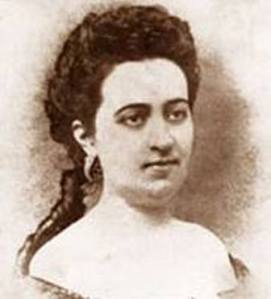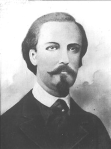One hundred and forty years ago today in the Jimaguayú savanna, Camagüey, a bullet pierced the skull of Mayor General Ignacio Agramonte y Loynaz. At just thirty-one years of age, Agramonte was arguably the most distinguished of all the military leaders of a war for the independence of Cuba that had been dragging on for almost five years, with no end in sight. The youthful Ignacio, scion of one of  the oldest and most prominent of the traditional Camagüeyano families, was educated in Europe, earned a law degree from the University of Havana, and was an accomplished fencer. He was the principal author of the constitution of the government-in-arms established by the Cuban rebels.
the oldest and most prominent of the traditional Camagüeyano families, was educated in Europe, earned a law degree from the University of Havana, and was an accomplished fencer. He was the principal author of the constitution of the government-in-arms established by the Cuban rebels.
Outflanked and surrounded by attacking Spanish troops, the fatal shot felled him from his horse and onto the tall grass, where his lifeless body lay abandoned until the enemy realized the prize they had netted and recovered it. The corpse was taken to the city of Camagüey, also known as Puerto Príncipe, Agramonte’s native town, paraded down the main street, and then summarily cremated. His family was not in Camagüey to mourn him. Ignacio and his cousin, Brigadier General Eduardo Agramonte y Piña, occupied such prominent roles in the insurrection that by 1871 their families had already left Puerto Príncipe, and Cuba, to avoid reprisals by the Spanish, especially by the fanatical paramilitary voluntarios.
The Agramonte family, like most exiles from the war, came to New York. The 1870 U.S. Census found Ignacio’s mother, María Filomena Loynaz, 46, a widow, living with her sister-in-law, Ignacio’s aunt and godmother, Mercedes Agramonte, 45, and with Ignacio’s brother, Enrique, 25, at 104 W. 20th Street, between Sixth and Seventh Avenues, in the Sixteenth Ward. There were also four teenagers in the household, nephews and nieces of María Filomena. In that household, Enrique was the most recent arrival from Cuba. He had been sent by his brother Ignacio after their father died in New York not long after the family arrived here.
Also in New York was the household headed by Dr. José Ramón Simoni, a sixty-year old physician enumerated in the 22nd Ward, on Sixth Avenue, just south of Central Park. Living with Dr. Simoni in New York were his wife Manuela, 50, their son José Ramón Jr., 22, and Manuela’s niece Victoria Ginferrer, 16. The household also included the Simonis’ two married daughters with their children.
The oldest, Amalia, twenty-five years old, had an infant son, Ignacio Ernesto, and was pregnant with a second. She was married to Major General Ignacio Agramonte. The other daughter, Matilde, was twenty-four and had a two-year old son, Arístides. She was married to Brigadier General Eduardo Agramonte. Sisters in New York married to cousins who were in the Cuban battlefields.On February 20,1871, Amalia gives birth in New York to her (and Ignacio’s) daughter, Herminia, and the new baby and her brother are baptized in October of that year in Holy Cross Church on West 42nd Street.
More than two years after that baptism, the news of Ignacio’s death would reach the two families. Ignacio’s mother received the news in New York. At that time, the Simoni family was living in Mérida, Yucatán, where Dr. Simoni had taken the family to try to reestablish his medical practice. Ignacio Ernesto was four and Herminia two.
Five months after Ignacio Agramonte’s death in 1873, Carlos del Castillo, who at the time was serving as a representative of the Cuban Republic in New York, received a letter from Dr. Simoni in Mérida, thanking del Castillo for sending him the official dispatch from General Manuel Sanguily that detailed the circumstances of the death of Ignacio. It was much appreciated by the widow, Simoni wrote. In a chilling postscript to the letter, Simoni requests from del Castillo the dispatch from the battle of San José del Chorrillo, which took place in 1872. “It is anxiously awaited by the widow of Eduardo Agramonte,” he wrote. Dr. Simoni found himself with two widowed daughters and three fatherless grandchildren.
Not long after the tragic news, Amalia and Matilde Simoni returned to New York from Mérida with their children. Amalia became a U.S. citizen on June 13, 1881, listing her occupation as “lady” and her address as 360 West 45th Street. Her son Ignacio Ernesto became a citizen much later in 1893 and listed his occupation as “civil engineer.”
Blanche Baralt, in her 1945 memoir of her youthful days in the New York of the 1880s and 1890s, remembers with affection the Simoni sisters and their children, noting especially the family’s joy on the graduation of Arístides, Matilde’s son, from the Columbia University College of Physicians and Surgeons. Matilde remarried and had three more children, all girls.
Amalia Simoni, Ignacio’s widow, never remarried. She returned to live in Cuba in 1892, an event recorded in Patria by José Martí. After living in Camagüey for many years, she moved to Havana to live in El Vedado with her daughter Herminia and her grandchildren. She died there in 1918, 45 years after Ignacio’s death, and was buried in the Colón necropolis on January 24, declared by President Mario García Menocal as a national day of mourning.
At the burial, her nephew Arístides, by that time a well-established physician and an important actor in the joint U.S.-Cuba effort to eradicate yellow fever in Cuba,thanked the multitude assembled at the gravesite for “accompanying to this sacred place the mortal remains of the exemplary compañera of the bravest, most courageous and daring soldier of our liberties, the undiminished hero of Jimaguayú, Mayor General Ignacio Agramonte.”



